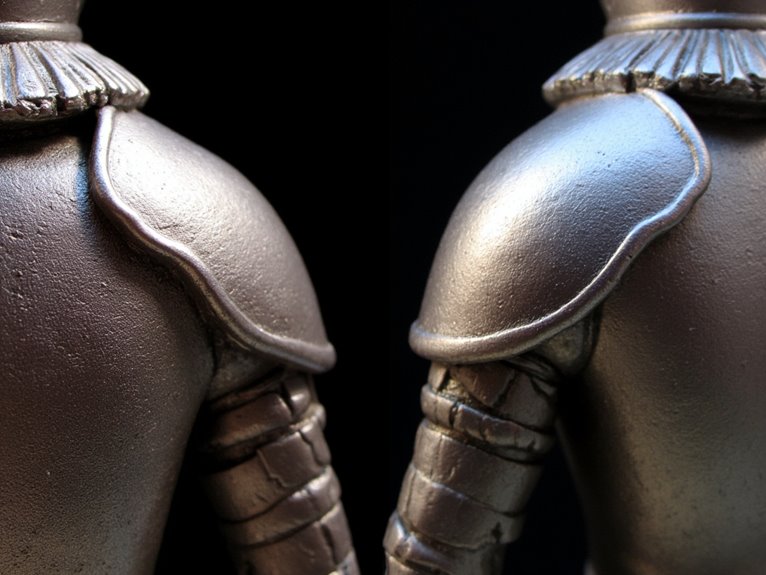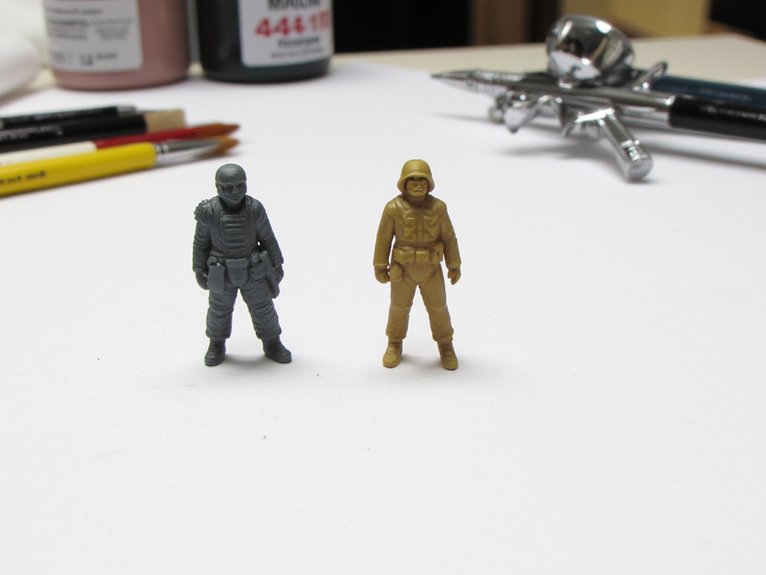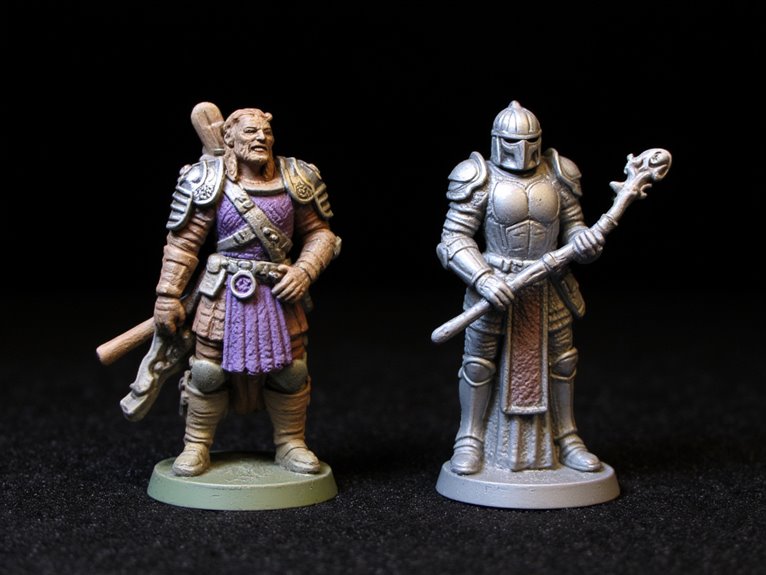We are supported by our audience. When you purchase through links on our site, we may earn an affiliate commission, at no extra cost for you. Learn more. Last update on 30th June 2025 / Images from Amazon Product Advertising API.
You’ll find airbrushes excel at speed and ultra-smooth finishes through atomized paint mist, while brushes offer superior precision for detail work and cost considerably less upfront. Airbrush systems start at $80-100 versus $15-25 for quality brushes, but require specialized paints and ongoing maintenance. Brushes provide direct control for fine lines and texturing techniques like dry brushing, whereas airbrushes need stencils for small details. Most experienced painters combine both tools strategically to maximize efficiency and quality across different project phases.
Notable Insights
- Brushes excel at fine details and precision work through direct bristle contact, while airbrushes create ultra-smooth finishes with atomized paint.
- Airbrush initial investment ($80-100) significantly exceeds quality brush sets ($15-25), with ongoing costs for specialized paints and maintenance.
- Airbrushes provide faster coverage on large areas, but brushes offer speed advantages for detailed work and shorter learning curves.
- Airbrushes require stencils or masking for small details, whereas brushes allow direct control for crisp lines and variable thickness.
- Combining both tools optimizes results: airbrush for smooth basecoats and gradients, followed by brush work for intricate detailing.
Speed and Efficiency Comparison
When you’re deciding between brushes and airbrushes for miniature painting, speed becomes the primary differentiating factor that’ll impact your entire workflow.
Airbrushes deliver superior application speed through atomized paint mist that creates thin, even layers without brush strokes. You’ll achieve faster coverage efficiency when base coating large models like tanks or painting entire armies. The spray pattern covers wide surfaces uniformly, while brushes require repetitive manual strokes.
However, brushes maintain speed advantages for detailed work and small areas.
Your learning curve affects initial performance—beginners often paint faster with brushes despite airbrushes’ higher ultimate speed potential. Setup and cleaning time can offset airbrush gains during short sessions, but extended painting favors airbrush efficiency through consistent, uniform coats requiring fewer corrections. Airbrushes excel at creating smooth gradients and transitions that would otherwise be challenging and time-consuming with traditional brush techniques. Ready-to-spray formulas eliminate the need for mixing paint ratios, streamlining workflow for miniature painting enthusiasts during extended sessions. Both methods achieve superior results when precision and practice are applied consistently over time.
Paint Finish Quality and Surface Texture

When you’re evaluating paint application methods, the fundamental difference lies in how each tool deposits paint onto your miniature’s surface.
Airbrushes create ultra-smooth finishes by atomizing paint into fine particles that settle evenly without visible application marks, while brushes inherently leave textural evidence of their bristles and stroke patterns. Airbrush blending enables smooth transitions between colors, allowing you to layer multiple miniatures within minutes without the visible demarcation lines typical of brush work. Modern airbrush paints feature particle sizes of 35μm or smaller, which prevents clogging and ensures consistent coverage across detailed miniature surfaces.
This distinction affects not only the visual appearance of your finished model but also determines which painting techniques you can effectively employ for different surface effects. In contrast, brushes enable advanced techniques like dry brushing and layering that create unique textural effects difficult to achieve with airbrushing alone.
Smooth Airbrush Coats
Atomized paint particles create the foundation of airbrush superiority in achieving flawless surface finishes on miniatures. Your airbrush application delivers thin, even coats through precise pressure control and paint atomization. This technique eliminates brush stroke marks completely.
Low-pressure settings with properly thinned paint produce buttery smooth layers that preserve fine model details. You’ll achieve smooth gradations between colors through multiple light coats rather than heavy single applications. Each layer builds gradually without pooling or clumping.
The consistent paint flow prevents surface texture irregularities common in brush painting. Your trigger control enables precise paint deposition rates. Multiple thin coats dry quickly, allowing rapid layer buildup.
This creates uniform surface texture ideal for advanced techniques like glazing. The resulting smooth foundation supports weathering effects and detail work without interference from underlying texture imperfections. Airbrush techniques yield smoother finishes compared to spray cans while maintaining superior control over paint application. Water-based acrylics offer easy cleanup and straightforward application when used with airbrush equipment.
Textured Brush Techniques
While airbrushes excel at creating smooth surfaces, brushes dominate the domain of textured finishes through deliberate surface manipulation techniques.
You’ll achieve superior contrast and dimensional depth using brush-specific methods that airbrushes simply can’t replicate.
Dry brushing techniques involve loading minimal paint on wide brushes, then lightly dragging across raised surfaces. This selectively highlights edges and textures while avoiding recesses.
The flicking method uses brush tips to transfer paint unevenly across detailed areas, creating natural-looking surface variations. Flat brushes prove particularly effective for larger figures during drybrushing applications.
Essential Brush Texture Methods:
- Three-color layering – Apply basecoat, mid-tone, and highlight progressively for dimensional depth
- Pressure variation – Control paint deposition through varied brush pressure and stroke direction
- Selective application – Target specific areas inaccessible to airbrushes for enhanced detailing
These techniques produce tactile surface variations that simulate realistic materials effectively.
Precision and Detail Control Capabilities
The fundamental difference between brushes and airbrushes lies in their precision mechanisms—brushes provide direct, tactile control through bristle contact, while airbrushes deliver paint via a cone-shaped mist pattern.
Brush control enables extremely fine line techniques through direct bristle manipulation. You can paint microscopic details like eyes and facial features with pinpoint accuracy. Liner brushes specifically cater to intricate outlines and delicate highlights that airbrushes can’t match without additional masking tools.
| Feature | Brush | Airbrush |
|---|---|---|
| Fine Detail Work | Direct bristle contact enables microscopic precision | Requires stencils/masking for small details |
| Line Quality | Crisp, controlled lines with variable thickness | Soft lines requiring additional techniques |
| Color Application | Full saturation with controlled thickness | Slight desaturation, thinner coverage |
Airbrushes excel at smooth gradients but lack the spot-specific control necessary for detailed miniature work. Professional miniature painters often invest in specialized brush sets that include various brush types like liners, rounds, and angled spot brushes to achieve maximum precision across different painting techniques.
Learning Curve and Skill Development

You’ll face distinctly different challenges when developing skills with each tool.
Airbrush mastery demands technical coordination between air pressure settings and paint flow rates, plus dedicated time for setup and maintenance procedures that can overwhelm beginners.
Brush painting offers a gentler entry point with simpler tool requirements, allowing you to build fundamental paint handling skills before progressing to more advanced stroke techniques and detail work.
For miniature painting specifically, dual-action airbrushes provide superior control for intricate detail work but require significant practice to master the trigger coordination and pressure adjustments.
Airbrush Mastery Challenges
Mastering an airbrush presents a steep technical learning curve that requires coordination, precision, and patience. You’ll face immediate challenges coordinating trigger control—pushing for airflow while pulling for paint flow necessitates muscle memory development.
Paint viscosity management becomes critical as over-thinning causes spattering while thick paint clogs nozzles.
Key airbrush techniques that challenge beginners include:
- Trigger modulation – Gradual pressure adjustments prevent paint pooling and detail loss.
- Distance control – Maintaining consistent spacing from miniatures ensures even coverage.
- Layering precision – Building thin coats without obscuring surface details.
You’ll encounter equipment issues like hose kinks and gasket leaks that degrade spray quality. Neglecting test sprays leads to unexpected results on finished models.
Cleaning protocols demand attention—skipping maintenance creates irregular patterns and costly repairs.
Brush Skill Progression
While airbrush challenges center on equipment coordination and technical setup, brush painting demands a different skill foundation built through progressive motor control development.
Your brush stroke evolution begins with mastering downstrokes, pull strokes, and push strokes using minimal paint loads. Early techniques rely on brush sides for edge highlighting, but advancing requires precise tip control for finer details.
Control mastery develops through consistent practice building muscle memory. You’ll progress from basic strokes to sophisticated layering and blending techniques by adjusting pressure, angle, and paint consistency.
Intermediate skills include manipulating stroke width for dimensional effects and managing brush moisture for smooth gradients.
Complex challenges emerge with razor-sharp edge highlights requiring steady downstroke precision. Managing brush wear becomes critical as damaged bristles limit technique advancement.
Success depends on deliberate practice targeting challenging miniature features.
Equipment Investment and Ongoing Costs
The financial commitment between brush and airbrush painting reveals a significant gap that extends far beyond the initial purchase price.
Airbrush painting demands substantially higher financial investment than traditional brush techniques, creating barriers for budget-conscious artists.
Equipment affordability creates the most obvious distinction. Quality brushes cost $15-25 each, while airbrush kits start at $80-100 for entry-level setups.
Professional airbrush systems require compressors, moisture traps, and pressure regulators, pushing costs into hundreds of dollars.
Maintenance requirements compound these differences over time:
- Brush care involves simple soap-and-water cleaning with minimal replacement costs.
- Airbrush maintenance demands frequent deep cleaning and periodic needle/nozzle replacements.
- Ongoing expenses include specialized paints, thinners, and electricity for compressor operation.
Brushes offer incremental replacement options, allowing budget control.
Airbrush systems typically require bundled component purchases when parts wear out.
Compressor repairs can be costly, unlike brushes which need no powered equipment.
Professional airbrush kits often include multiple nozzle sizes (0.2mm, 0.3mm, 0.5mm) to accommodate different detail levels, adding value but increasing complexity for beginners.
Project Suitability and Application Methods

Your choice between brush and airbrush depends heavily on the specific project characteristics and desired painting outcomes you’re targeting.
Technique selection becomes essential when considering project scope. Airbrushes excel with large-scale models requiring extensive surface coverage, delivering smooth basecoats through atomized paint mist. You’ll achieve seamless blending and natural gradients impossible with traditional brushwork.
However, brushes dominate intricate detail work where precision control matters most. They enable specialized techniques like dry-brushing, stippling, and controlled washes that airbrushes can’t replicate effectively.
For maximum efficiency, combine both tools strategically. Start with airbrush coverage for rapid base layers, then switch to brushwork for fine details and finishing touches. This hybrid approach optimizes speed while maintaining detail quality across varied miniature projects.
Combining Both Tools for Optimal Results
Maximum painting efficiency emerges when you strategically combine both brush and airbrush techniques within a single project workflow.
This workflow synergy delivers superior results compared to single-tool approaches.
Technique integration follows a logical sequence that maximizes each tool’s strengths:
- Base Coverage Phase – Apply foundation colors and large-area coverage using airbrush at 50% paint dilution for smooth, even layers.
- Detail Application Phase – Use brushes for precise work on cockpit interiors, small crevices, and intricate surfaces where airbrush overspray creates problems.
- Finishing Integration Phase – Blend brush-placed contrasting colors with airbrush misting, then add final texture effects through dry brushing techniques.
This dual-tool approach reduces total painting time while improving finish quality.
You’ll achieve gradual shading impossible with brushes alone, while maintaining the precise control that airbrushes can’t provide in confined spaces.
On a final note
You’ll achieve the best miniature painting results by matching your tool to your specific project needs. Brushes excel at detail work and character painting with minimal setup costs. Airbrushes deliver superior basecoats and smooth gradients but require significant investment. Most experienced painters use both tools strategically—airbrushes for priming and large surfaces, brushes for details and finishing touches. Your skill level and project requirements determine the ideal approach for each miniature.

